Choosing the Right Grow Lights for Succulents
If you’re struggling to keep your succulents happy indoors, lighting might be the missing piece of the puzzle. While these hardy desert plants have adapted to thrive in various conditions, they won’t reach their full potential without proper illumination. You’ll notice your succulents stretching, losing their vibrant colors, or even failing to flower when their light needs aren’t met. Whether you’re dealing with dark winter months or a shadowy apartment corner, choosing the right grow lights can transform your lackluster plants into the stunning specimens they’re meant to be. Let’s shed some light on what your succulents really need to flourish.
Contents
Understanding Succulent Light Requirements
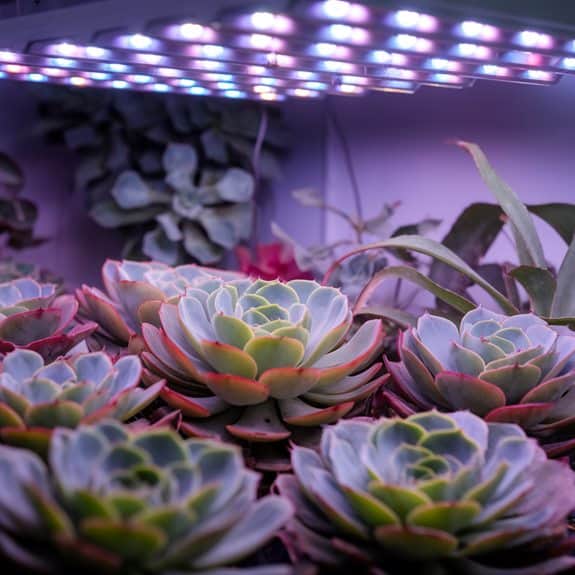
Three key factors determine how much light your succulents need: their natural habitat, color, and growth patterns.
Desert-native succulents need more light than forest-dwelling varieties. Vibrant reds and purples indicate higher light needs, while pale greens prefer less.
Watch your plants’ growth – if they’re stretching toward light sources, they’re crying out for more intensity.
Types of Indoor Grow Lights
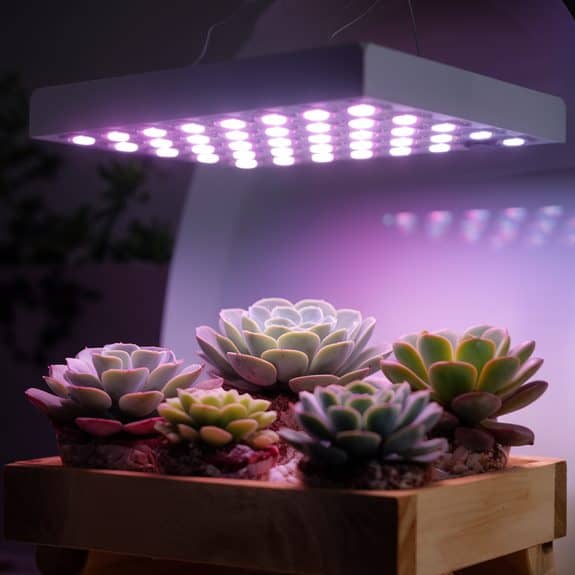
Indoor grow lights come in four main varieties for succulent care: LED, fluorescent, high-intensity discharge (HID), and incandescent bulbs.
LED lights offer energy efficiency and low heat output, while fluorescent tubes provide good coverage at a moderate cost.
HID lights deliver intense illumination but run hot and use more power. You’ll want to avoid incandescent bulbs, as they’re inefficient and produce too much heat.
LED Vs Fluorescent Options
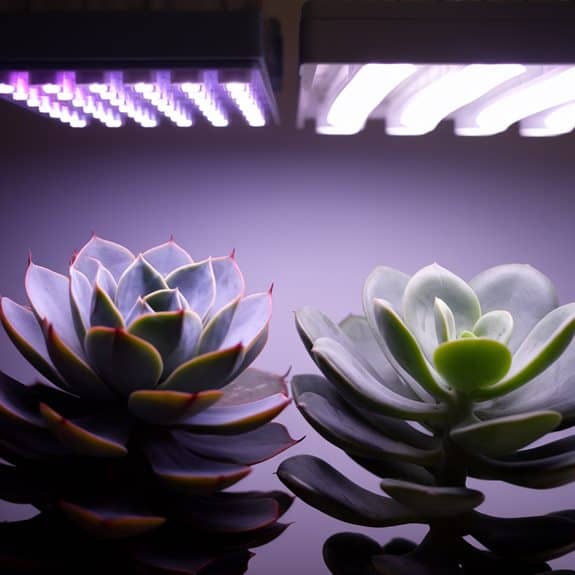
When narrowing down your grow light choices, LED and fluorescent options stand out as the top contenders for succulent care. LED lights run cooler, last longer, and use less energy, but they’ll cost more upfront.
Fluorescent bulbs are budget-friendly and effective, especially T5 and T8 models, but you’ll need to replace them yearly. Both options will give your succulents the light they crave.
Measuring Light Intensity
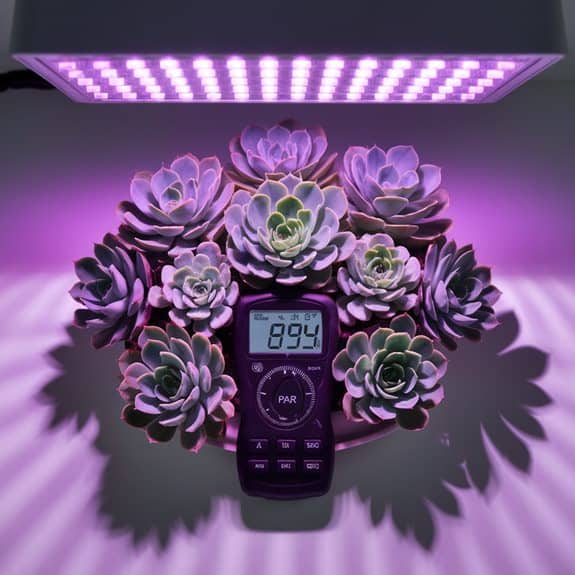
Successfully measuring light intensity requires both proper tools and basic knowledge of light requirements. You’ll need a PAR meter or light meter to measure your grow light’s intensity.
For most succulents, you’ll want readings between 2000-3000 lux for 12-14 hours daily. Position your meter at plant level and take multiple readings throughout the day for accurate results.
Proper Light Positioning
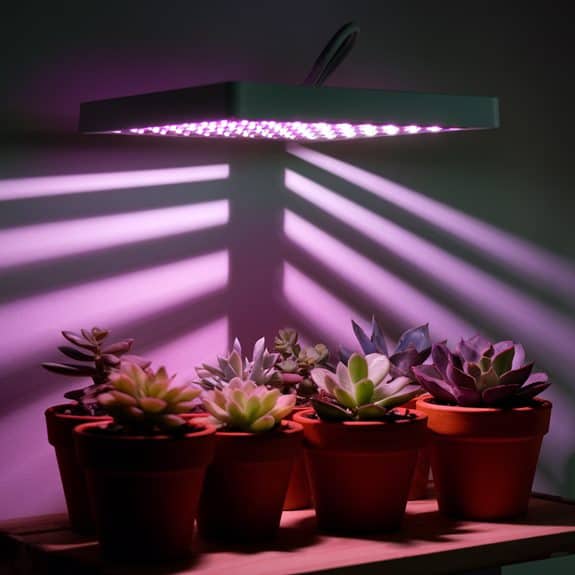
Three key factors determine excellent grow light positioning: height, angle, and coverage area. You’ll want to hang your lights 6-12 inches above your succulents, adjusting based on light intensity and heat output.
Position the lights at a 90-degree angle to guarantee even distribution. For optimal coverage, your light’s footprint should extend slightly beyond your plant collection’s outer edges.
Setting Up Your Lighting Schedule
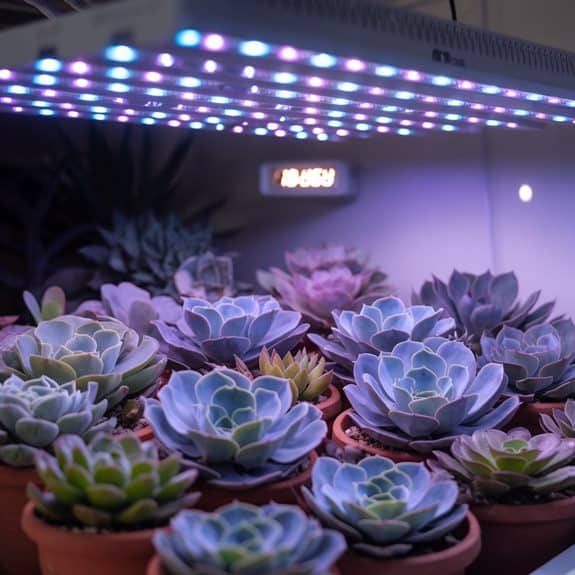
Setting up a proper lighting schedule can make or break your succulent’s growth. Start with 12-14 hours of light during spring and summer months, reducing to 10-12 hours in fall and winter.
You’ll want to mimic natural daylight patterns, so turn your lights on at sunrise and off at sunset. Use a simple outlet timer to maintain consistency and prevent forgetting.
Common Lighting Mistakes
Even with artificial lighting, you’ll need to avoid burning your succulents with too much direct exposure, as this can cause leaf damage and discoloration.
Your light’s color spectrum matters greatly, and using the wrong type can lead to stunted growth or stretched-out plants seeking proper light wavelengths.
If you’re using standard household LED bulbs, you mightn’t be providing the full spectrum of light your succulents need for ideal growth.
Too Much Direct Light
While succulents are known for their love of bright light, exposing them to excessive direct light under grow lamps can cause serious damage. You’ll notice signs of light stress like reddish-brown patches, bleaching, or yellowing leaves.
If you spot these symptoms, move your plants farther from the light source or reduce exposure time to prevent permanent leaf burn.
Wrong Light Color Spectrum
Light spectrum selection represents one of the most common mistakes in growing succulents indoors. When you’re using lights that don’t provide the right mix of blue and red wavelengths, your plants won’t thrive.
Your succulents need blue light (400-500nm) for foliage growth and red light (600-700nm) for flowering. Standard household bulbs won’t give you this essential balance.
Seasonal Light Adjustments
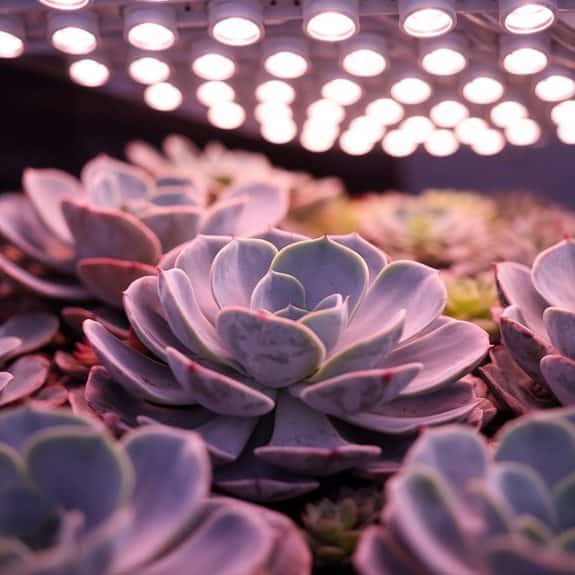
You’ll need to adjust your succulent’s grow light schedule between winter and summer to match natural lighting patterns, typically providing 14-16 hours in summer and 10-12 hours in winter.
Temperature fluctuations can affect how your succulents respond to light, so you’ll want to position grow lights slightly farther from plants during hot summer months to prevent leaf burn.
During winter’s cooler temperatures, you can safely move lights a bit closer while maintaining proper humidity levels for ideal growth.
Winter Vs Summer Hours
The seasonal shift from summer to winter requires adjusting your grow light schedule to mimic natural daylight patterns.
In summer, run your grow lights 14-16 hours daily to match longer days. During winter, reduce the duration to 10-12 hours, reflecting shorter natural daylight.
You’ll need to adjust these times gradually over several weeks to prevent shocking your succulents.
Temperature Impact on Light
Temperature plays an essential role in how your succulents respond to grow lights throughout different seasons. You’ll need to adjust your light’s distance when temperatures fluctuate.
In warmer conditions, keep lights slightly farther away to prevent leaf burn, while in cooler temperatures, you can position them closer since your plants are less likely to experience heat stress. Monitor your plants’ reactions and adjust accordingly.
